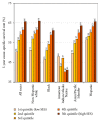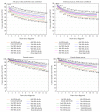Socioeconomic and Racial/Ethnic Disparities in Cancer Mortality, Incidence, and Survival in the United States, 1950-2014: Over Six Decades of Changing Patterns and Widening Inequalities
- PMID: 28408935
- PMCID: PMC5376950
- DOI: 10.1155/2017/2819372
Socioeconomic and Racial/Ethnic Disparities in Cancer Mortality, Incidence, and Survival in the United States, 1950-2014: Over Six Decades of Changing Patterns and Widening Inequalities
Abstract
We analyzed socioeconomic and racial/ethnic disparities in US mortality, incidence, and survival rates from all-cancers combined and major cancers from 1950 to 2014. Census-based deprivation indices were linked to national mortality and cancer data for area-based socioeconomic patterns in mortality, incidence, and survival. The National Longitudinal Mortality Study was used to analyze individual-level socioeconomic and racial/ethnic patterns in mortality. Rates, risk-ratios, least squares, log-linear, and Cox regression were used to examine trends and differentials. Socioeconomic patterns in all-cancer, lung, and colorectal cancer mortality changed dramatically over time. Individuals in more deprived areas or lower education and income groups had higher mortality and incidence rates than their more affluent counterparts, with excess risk being particularly marked for lung, colorectal, cervical, stomach, and liver cancer. Education and income inequalities in mortality from all-cancers, lung, prostate, and cervical cancer increased during 1979-2011. Socioeconomic inequalities in cancer mortality widened as mortality in lower socioeconomic groups/areas declined more slowly. Mortality was higher among Blacks and lower among Asian/Pacific Islanders and Hispanics than Whites. Cancer patient survival was significantly lower in more deprived neighborhoods and among most ethnic-minority groups. Cancer mortality and incidence disparities may reflect inequalities in smoking, obesity, physical inactivity, diet, alcohol use, screening, and treatment.
Figures






References
-
- US Department of Health and Human Services. Healthy People 2020, http://www.healthypeople.gov/2020/default.aspx. - PubMed
-
- National Center for Health Statistics. Health, United States, 2011 with Special Feature on Socioeconomic Status and Health. Hyattsville, Md, USA: US Department of Health and Human Services; 2012. - PubMed
-
- Singh G. K., Williams S. D., Siahpush M., Mulhollen A. Socioeconomic, rural-urban, and racial inequalities in US cancer mortality: Part I-all cancers and lung cancer and part II-colorectal, prostate, breast, and cervical cancers. Journal of Cancer Epidemiology. 2011;2011:27. doi: 10.1155/2011/107497.107497 - DOI - PMC - PubMed
MeSH terms
LinkOut - more resources
Full Text Sources
Other Literature Sources
Medical

